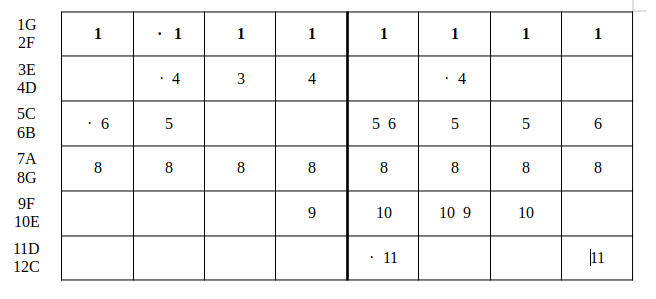Hi Pierre
Yes, I like that. I hadn't come across \tiny before, it does help make things nicer. I assume that the "tenor bells" is simply an artefact from a template - I can't see that it does anything. In the alto bells would you advise the rest? Remember that ringers are following a line and a space of the staff, not a line of music, and I would think that s2 would be better.
I assume the \voiceXXX clauses are to set the stem directions?
Thanks,
Martin
On Sun, 2022-12-04 at 22:48 +0100, Pierre Perol-Schneider wrote:
Hi Martin,Sorry but the last attempt is hardly readable.As Michael suggested previously, precising voices might help ; also, you could change some voice sizes for a better reading.E.g. something like:
sopranBells = \fixed c'' {
\voiceOne
| %mes. 13
g4 r8 g8 4 4
| %mes. 14
g4 4 4 4
| %mes. 15
s4
}
bassBells = \fixed c' {
\voiceTwo
| %mes. 13
g4 <g c'> <e g> <d g>
| %mes. 14
<e g c'>4 q <e g c'> <d g b>
| %mes. 15
s4
}
tenorBells = \fixed c' {
\voiceThree \tiny
| %mes. 13
s1
| %mes. 14
s1
| %mes. 15
s4
}
altoBells = \fixed c' {
\voiceTwo \tiny
| %mes. 13
s8 b s d' d'2\rest
| %mes. 14
s8 <d b> s <f d'> s4 s
| %mes. 15
s
}
\new Staff <<
\new Voice \sopranBells
\new Voice \bassBells
\new Voice \tenorBells
\new Voice \altoBells
>>HTH, cheers,PierreLe dim. 4 déc. 2022 à 22:06, J Martin Rushton <martinrushton56@btinternet.com> a écrit :Hi MichaelIt just takes having to explain something to sort it. Those two problematic bars are now:which is much better. I still don't really like the tied quavers where a crotchet is rung, but then you can't have everything! The relevant code is:g8 ~ <g b>8 <g c>8 ~ <g c d>8 <g e>4 <g d>4 | <e g c>8 ~ <d e g b>8 <e g c>8 ~ <f g c d>8 <e g c>4 <d g b>4 |for the accompaniment.Thanks for making me think!MartinOn Sun, 2022-12-04 at 20:39 +0000, J Martin Rushton wrote:Hi MichaelI've mocked up the same two bars in LibreOffice as tablature:Where you see a dot and a number, the dot indicates half a beat's rest, so that row three of the first beat is interpreted as r8 b8 In the second bar, first beat, the "5 6" is c8 b8 The bolded top row indicates the tune, which typically needs to be run a little harder whilst the lower bells ring softer. The problem comes with setting, for instance, the first beat. I tried using things like<< \relative c' {\stemDown g'4 <g c>4 g4 <g f>4 } \\ \relative c' { s8 b'8 s8 d8 e4 d4 } >> | << \relative c' { <g' e>4 <c g>4 } \\ \relative c' \autoBeamOff { c'8 <b d,>8 e,8 <d' f,>8 } >> <c' g e>4 <b g d>4 |for the accompaniment but it is horrible and confused. I've a feeling that need to change the g'4 in the first beat to g'8 ~ g8 to keep all the stems together. I'll report back after testing.I hope that that clarifies things a little,MartinOn Sun, 2022-12-04 at 13:14 -0500, Michael Werner wrote:Hi Martin.Well, I'm still pretty new to Lilypond but I have done some handbell music. I don't play them myself - my mother is the musician while I'm her tech support, I guess would be the way to phrase it. My approach with the more complex pieces her group was doing was to generate a somewhat simplified version just for her. I would make sure to retain enough of the main melody line that she could follow it, while cutting out anything else I could. Of course I had to make sure to leave in the notes that she was responsible for. Wouldn't work too well without them. Also I would put a larger callout symbol above each note she rings to help her see them - she's pushing 80 years old and her eyesight is going. While I was at it, I would also produce a complete version. But that was mainly just me playing around and gaining some experience.A lot of that was made a bit easier by just carving up the piece in multiple voices, with each voice going into a variable. Then I could assemble the appropriate piece of music by just calling the variables I needed for that particular version. Lots of possibilities to redo entire scores without having to retype a whole bunch of music.As for handbell tablature I've never seen it. None of the handbell music she has brought home for me to play with has had any tablature, just the "normal" music. Tablature for a few other instruments, yes, but not handbells.Well, this was kind of rambling - sorry about that. Like I said I'm still kinda new to Lilypond. It's been an interesting journey so far, with still quite a long ways to go. Still trying to get a decent grasp on the whole Scheme thing. Oh well. Just gotta keep trying, I guess. Hope maybe something in all this might have helped maybe a bit.MichaelOn Sun, Dec 4, 2022 at 12:46 PM J Martin Rushton <martinrushton56@btinternet.com> wrote:Hi all,Our handbell team rings some pieces from normal scores, and some from a tablature notation. I had a go at converting one of our favourite pieces from tablature to scores, but some of the bars become so complex that I'm not sure this helps at all.Has anyone else done handbells on Lilypond? As a supplementary question, does anyone know of any software that can generate handbell tablatures?Thanks,Martin--J Martin Rushton MBCS--J Martin Rushton MBCS--J Martin Rushton MBCS
--
J Martin Rushton MBCS


